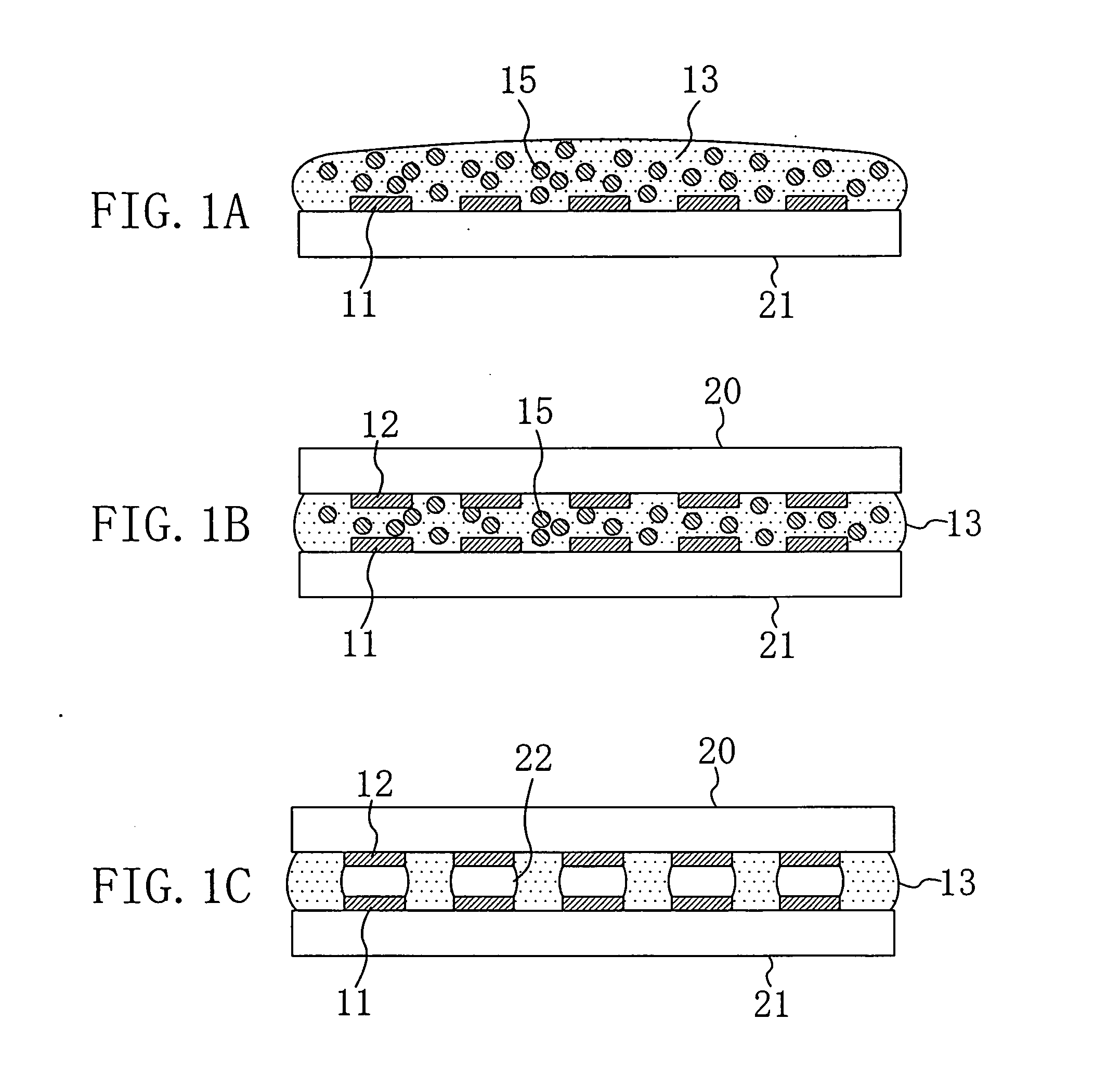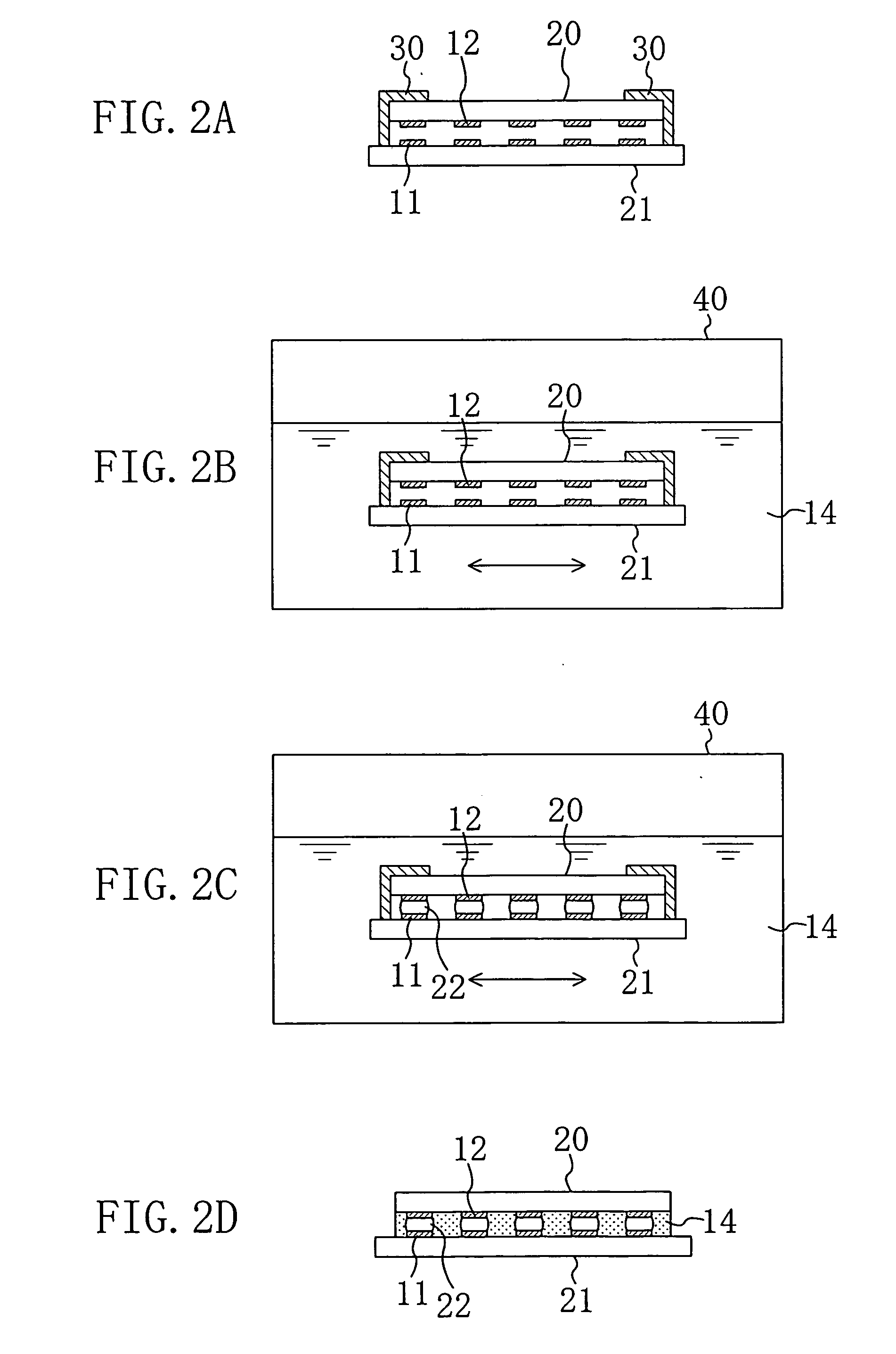Flip-Chip Mounting Method and Bump Formation Method
a technology of bump formation and flip-chip, which is applied in the direction of sustainable manufacturing/processing, final product manufacturing, semiconductor/solid-state device details, etc., can solve the problems of increasing the demands for reducing the dielectric constant, the difficulty of coping with this fine pitch, and the seriousness of rapid operation and power consumption loss, etc., to achieve easy quality control of the dipping bath, high wettability, and efficient incorporation
- Summary
- Abstract
- Description
- Claims
- Application Information
AI Technical Summary
Benefits of technology
Problems solved by technology
Method used
Image
Examples
embodiment 1
[0084]FIGS. 2a through 2d are cross-sectional views for showing basic procedures in a flip-chip mounting method according to Embodiment 1 of the invention.
[0085] First, as shown in FIG. 2A, a semiconductor chip 20 having a plurality of electrode terminals 12 is held by a fixing jig 30 so as to oppose a circuit board 21 having a plurality of connection terminals 11 with a given gap (of, for example, 10 through 100 μm) provided therebetween. At this point, the electrode terminals 12 of the semiconductor chip 20 and the connection terminals 11 of the circuit board 10 are aligned to oppose each other.
[0086] At this point, the fixing jig 30 may be anything as far as it can fix the semiconductor chip 20 and the circuit board 21 with the given gap provided therebetween, and a spacer may be inserted between the semiconductor chip 20 and the circuit board 21 for keeping the given gap.
[0087] Next, as shown in FIG. 2B, the semiconductor chip 20 and the circuit board 21 held with the given g...
embodiment 2
[0116] In the flip-chip mounting method described in Embodiment 1, a circuit board and a semiconductor chip are dipped in a dipping bath containing a melted resin including melted solder particles for a given period of time, so as to make the melted solder particles self-assemble between terminals of the circuit board and the semiconductor chip for forming connectors. This technique is also applicable to a bump formation method.
[0117]FIGS. 6A through 6D are cross-sectional views for showing basic procedures in a bump formation method according to Embodiment 2 of the invention. It is noted that detailed description of procedures commonly performed in the flip-chip mounting method shown in FIGS. 2A through 2D is omitted.
[0118] First, as shown in FIG. 6A, a substrate 25 having a plurality of electrodes 27 is held by a fixing jig 30 so as to oppose a flat plate 26 with a given gap (of, for example, 10 through 100 μm) provided therebetween.
[0119] Next, as shown in FIG. 6B, the substra...
embodiment 3
[0125]FIGS. 7 and 8 are diagrams of a mounting apparatus 50 used for executing the flip-chip mounting method of this invention.
[0126] The mounting apparatus 50 shown in FIG. 7 includes a fixing jig 30 for holding a semiconductor chip (not shown) and a circuit board (not shown) to oppose each other with a given gap provided therebetween, a dipping bath 40 containing a melted resin 14 including melted solder particles, and a conveyor 60 for conveying the fixing jig 30 into the dipping bath 40, and further includes annealing means 70 if necessary.
[0127] In this mounting apparatus 50, the fixing jig 30 holding the semiconductor chip and the circuit board is dipped in the dipping bath 40 by using the conveyor 60, so as to make the melted solder particles contained in the dipping bath 40 self-assemble between connection terminals of the circuit board and electrode terminals of the semiconductor chip, and thus, connectors are formed between these terminals.
[0128] The semiconductor chip ...
PUM
| Property | Measurement | Unit |
|---|---|---|
| temperature | aaaaa | aaaaa |
| time | aaaaa | aaaaa |
| grain size | aaaaa | aaaaa |
Abstract
Description
Claims
Application Information
 Login to View More
Login to View More - R&D
- Intellectual Property
- Life Sciences
- Materials
- Tech Scout
- Unparalleled Data Quality
- Higher Quality Content
- 60% Fewer Hallucinations
Browse by: Latest US Patents, China's latest patents, Technical Efficacy Thesaurus, Application Domain, Technology Topic, Popular Technical Reports.
© 2025 PatSnap. All rights reserved.Legal|Privacy policy|Modern Slavery Act Transparency Statement|Sitemap|About US| Contact US: help@patsnap.com



